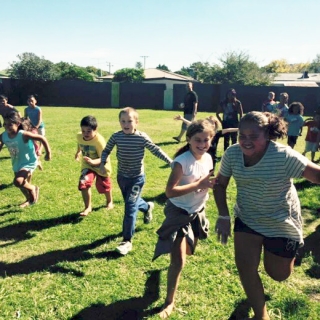FEATURED STORIES
Case Studies & Initiative Journeys
Case Studies described here are real examples of how an organisation has used an approach in Aotearoa New Zealand. Contact the featured organisation if you want to find out more. Please contact us to find out if there is a case study you think might be good to profile on this site.
Tīakīna ō Tātou Tamariki – Keeping Our Kids Safe
Evaluative Approach
Statutory Data
Organisation
Te Ora Hou Te Tairawhiti
Location
Tairawhiti

Contact Information
Te Ora Hou Website
Overview
This project began in 2010. Residents of a Gisborne neighbourhood and volunteers from Te Ora Hou, a local youth and community development organisation, decided to see whether they could build better relationships, networks and trust and in doing so, make children safer. They thought residents and the wider community would benefit too.
The neighbourhood they chose had high rates of child abuse and hospitalisation, youth offending, and family and street violence. Statutory agencies record these incidents when they know about them.
The project employs ‘Community Animators’ based in the community and they help with a range of activities to encourage greater social cohesion, cooperation, concern and care between neighbours.
They based their work on the Strong Communities / Strong Families programme from South Carolina in the USA. Professor Gary Melton and Clemson University supported that project with a large body of empirical evidence demonstrating a strong connection between social capital – families helping families – and a reduction in child abuse and neglect.[1]
Organisers have gathered evidence about the programme’s effectiveness by door-to-door neighbourhood surveys, anecdotal reactions (observation) from community members and local leaders, and by reading statutory agency data. Combining this information, especially when it is compared with data from similar neighbourhoods, is helping to show change over time.
[1] Melton, G. B. et al. Community Life, Public Health and Children’s Safety in Family and Community Health, Vol. 31, No. 2, pp.84-99. 2008, Wolters Kluwer Health

Using Surveys and Statutory Data
In 2009-2010, at the start of the project, organisers surveyed one-in-five households in the neighbourhood. Survey questions focused on issues such as how long the residents had lived in the area, whether they liked it and planned to be there in five years, how much and what type of interactions resident had with their neighbours and how well they knew and trusted each other. It also asked how much confidence they had in local organisations, including government agencies, schools, churches, iwi organisations, social services and health providers.
In 2013, organisers surveyed the same area and with the same sample size, although not necessarily the same households. The results show very positive improvements in all of the social capital measures used.
Highlights include:
- Residents who said they enjoy living in the neighbourhood increased from 67% to 100%.
- Residents who knew the names of more than 10 children in their street increased from 12% to 38%.
- Residents who had shared their phone numbers with other residents increased from 41% to 50%.
- Residents who reported having done something social with their neighbours increased from 51% to 69%.
Recent statistics from Police for the same neighbourhood showed a large reduction in violence and crime compared with the wider region. Data from Child Youth and Family, the District Health Board and Housing New Zealand is also collected.
Opinions from community leaders is also being used as evidence of positive change – for example a local school principal recently noted that
Whānau from [the project neighbourhood] are much more positive and seem more hopeful than our whānau from the other side of [the] suburb.”
Advice for accessing and using Statutory Data
Manu Caddie has managed the project since it began and has found that public officials and philanthropic funders believe statutory data to be credible.
“I guess this data is seen as ‘hard data’, if it’s from ‘official’ sources then it must be reliable and if shows significant change then that is of interest to the people responsible for services and community leadership,” Manu says. He says he doesn’t assume though that statutory agency data is always accurate and neither does he draw conclusions from it too quickly.
We all like to see good news, especially when it comes to thorny issues like child abuse and family violence. The best part so far is there seems to be some correlation between an increase in residents’ care and trust, and a decrease in the bad stuff recorded by agencies.”
While government agencies have been releasing more information publicly, Manu says it’s time-consuming to extract and then interpret the data.
“It’s mostly come down to finding someone within the government agency at a local or national level who we have connected to in person and made the case for sharing the data. ”
He says the public service has many horror stories of releasing personal data to the wrong people, so they’re nervous about providing it. They also worry that the data could be used against the agency or a community if its misunderstood or misused.
With a background in advocacy and politics, Manu says he finds it easy to go personally to the regional head of an organisation and ask for the data directly.
Some people may not be so confident, but it is the quickest way to get action – if you’re doing something worthwhile and can explain in a meeting how that data will help communities take ownership of the issues, I’ve found doors will open. “
He says there are still a number of layers of bureaucracy to get through, but if the local manager is onside then the rest of the organisation is usually willing to help.
Project staff and volunteers have spent many hours analysing the raw Police and Child Youth and Family data.
“They provide it as ‘clean’ data in the sense that there is nothing in the information that could be used to identify an individual or household, but it is literally every type of incident we have asked for in the communities we are interested in over the time period we are interested in.”
He uses census area units and urges other to be very specific when they ask for data. While Manu uses census data, he says other services and projects might focus on, say, age, ethnicity or gender demographics within the region.
Manu says the project has needed someone who is competent using spreadsheets and creating simple charts from large amounts of information.
Te Ora Hou has also been working online using statutory data to build community profiles at the census area unit level.
Manu says there’s a huge amount of data held by government agencies that the public never sees. He believes making it more accessible will increase awareness about the strengths and weaknesses of communities and let them use it to help themselves.
